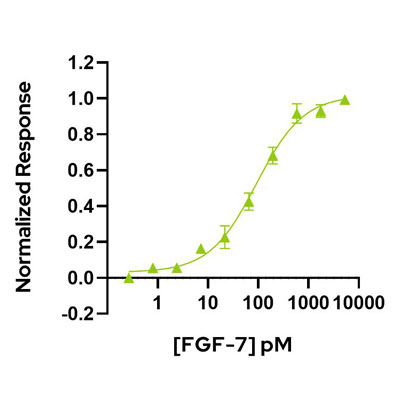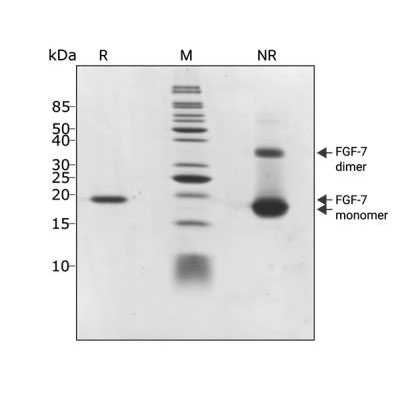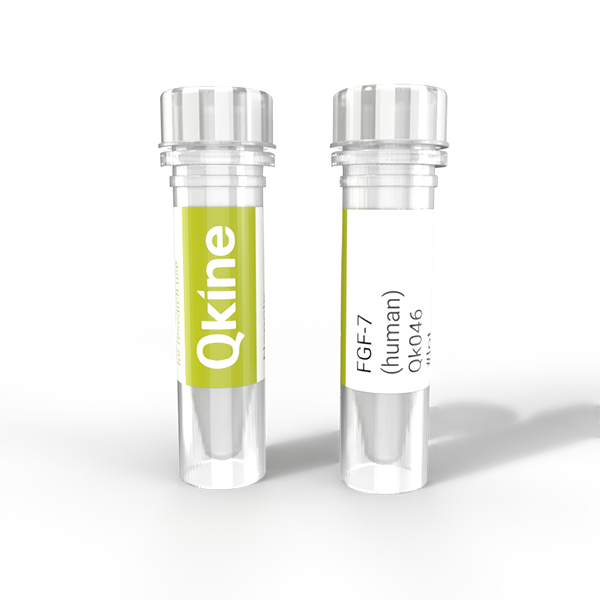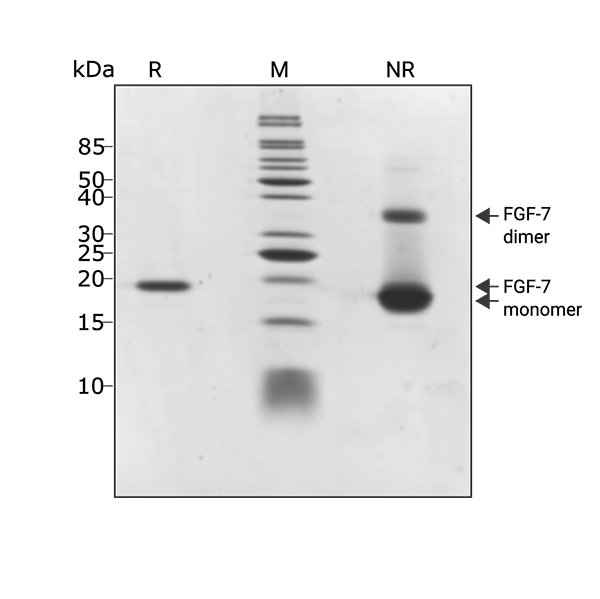Currency
Recombinant human KGF (FGF-7) protein (Qk046)
Human KGF protein (FGF-7) is a member of the FGF family. KGF protein is used in the culture of lung, breast, liver, and bladder organoids.
Qkine human FGF-7 / KGF is a highly pure and bioactive 19 kDa protein, animal-origin free (AOF) and carrier-protein free (CF).
Orders are typically shipped same or next day (except Friday).
Easy world-wide ordering, direct or through our distributors.
1000µg will be despatched as 2 x 500µg
Fast and free shipping.
Buy online with secure credit card or purchase order.
For any questions, please email orders@qkine.com
Summary
High purity FGF-7 / KGF protein (Uniprot: P21781)
>98%, by SDS-PAGE quantitative densitometry
19 kDa
Expressed in E. coli
Animal origin-free (AOF) and carrier protein-free
Manufactured in our Cambridge, UK laboratories
Lyophilized from PBS
Resuspend in water at >100 µg/ml, prepare single use aliquots, add carrier protein if desired and store frozen at -20 oC or -80 oC
Featured applications
Airway, mammary, liver hepatocyte, and urothelium organoids
Fibroblast growth factor 7, Keratinocyte growth factor, KGF, Keratinocyte growth factor 1, KGF1 HBGF-7, Heparin-binding growth factor 7
Mature human FGF7, which is active across species, shares 98% aa sequence identity with bovine, equine, ovine and canine, 96% with mouse and porcine, and 92% with rat KGF
Bioactivity

FGF-7 (KGF) activity is determined using the Promega serum response element luciferase reporter assay (*) in transfected MCF-7 cells. Cells are treated in triplicate with a serial dilution of KGF for 4 hours. Firefly luciferase activity is measured and normalized to the control Renilla luciferase activity. EC50 = 92 pM (1.75 ng/mL). Data from Qk046 lot #104314. *Promega pGL4.33[luc2P/SRE/Hygro] #E1340
Purity

KGF protein migrates as a monomer at 19 kDa and a dimer at 38 kDa in non-reducing (NR) conditions and 19 kDa upon reduction (R). No contaminating protein bands are visible. Purified recombinant protein (3 µg) was resolved using 15% w/v SDS-PAGE in reduced (+β-mercaptothanol, R) and non-reduced (NR) conditions and stained with Coomassie Brilliant Blue R250. Data from Qk046 lot #104314
Further quality assays
Mass spectrometry: single species with expected mass
Endotoxin: <0.005 EU/μg protein (below level of detection)
Recovery from stock vial: >95%
We are a company founded and run by scientists to provide a service and support innovation in stem cell biology and regenerative medicine. All our products are exceptionally high purity, with complete characterisation and bioactivity analysis on every lot.

Comparison with other suppliers
KGF (FGF-7) from Qkine (Qk046) and a major supplier have equivalent bioactivity. Qk046 KGF (FGF-7) lot #104425 and KGF from another supplier were compared in the same assay plate with EC50s of 2.0 ng/ml and 3.7 ng/ml respectively. We were really pleased with how happy the cells were with our KGF and look forward to hearing feedback from customers!
Kerry, Qkine senior scientist
Protein background
Keratinocyte growth factor (KGF), also known as fibroblast growth factor-7 (FGF-7), is part of the large FGF family, and, alongside FGF-3, FGF-10, and FGF-22, is a member of the FGF-7 subfamily. This subfamily is secreted exclusively by the mesenchyme, and specifically activates the “b” isoforms of FGFR1 (FGFR1b) and FGFR2 (FGFR2b) present in the overlying epithelium [1], of these receptors KGF acts through the IIIb splice form of FGFR2. KGF is required for the development of the kidney, thymus, and hippocampus [2]. KGF also plays an import role in wound healing [3], a role exemplified in studies on bioengineered skin [3]. KGF protein has been used in generation of many organoids including lung, breast, liver and bladder [2].
Our products are for research use only and not for diagnostic or therapeutic use. Products are not for resale.
Share your thoughts!
Let us know what you think...
What others are saying




liver organoids
Dylan Liabeuf –
Thanks to the high purity and quality of Qkine’ proteins (hu-FGF7), we were able to maintain selected liver cells derived from adult patient specimens as organoids over time and passage them.
Upvote if this was helpful (1) Downvote if this was not helpful (0) Flag for removal
Question
Anonymous –
Where are references 1, 2, 3 and 4 referred to in the protein background above?
Upvote if this was helpful (0) Downvote if this was not helpful (0) Flag for removal
Mairi Shepherd –
The references can be found near the top of the page, in the ‘background references’ toggle, next to the summary table
Upvote if this was helpful (0) Downvote if this was not helpful (0) Flag for removal